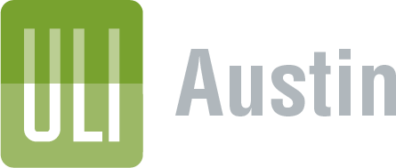Austin is booming, and nowhere is that more apparent than in the city’s downtown. With that boom and the related real estate development comes a need to define the urban experience. As new buildings rise above the city’s streetscape, levels and levels of parking decking are layered into the building’s foundation, creating a meaningful void in activation along downtown streets. Pedestrians pass these new shiny buildings and are met with garage entrances leading to multiple levels of parking before any human experience – whether residential or commercial – can be seen on the floors far above. In some cases, street-level retail is factored into the first floor of the building, but in many other instances, there is no opportunity for human interaction.
Understanding the impact that unfettered parking construction is having and will continue to have on the streetscape experience in downtown Austin, the City Council leadership turned to ULI Austin for guidance in encouraging a reduction in new parking construction across the entire downtown geography.

Highlights from the TAP report included:
Parking Policy Changes for New Development
- Use parking caps to limit parking facilities in new developments.
- Modify floor area ratio (FAR) to limit new parking construction.
- Encourage decoupling parking from residential assets.
- Encourage shared parking.
- Allow flexible uses of public rights-of-way.
- Improve wayfinding.
- Require Great Street standards across downtown.
- Expand policy changes beyond downtown.
Parking Management Reform
- Increase on-street parking fees.
- Free on-street spaces for other mobilities and short-term parking only.
- Expand the Affordable Parking Program.
- Expand parking management geography.
Improve the Human Experience
- Prioritize shade.
- Improve accessibility.
- Activate street fronts.
- Encourage complete communities.
Improving Other Mobility Options
- Expand downtown public transit.
- Improve the biking and walking experience.
- Encourage car-share and micro-mobility options.
- Explore transportation demand management (TDM) and transportation management associations (TMA).
Promote Education and Cultural Shift
- Make transit options more visible across downtown.
- Better integrate transit stops with new real estate developments.
- Provide information and education on how and where to use transit.
- Improve CapMetro’s transit mobile app.
Improve City Collaboration and Processes
- Communicate a singular vision.
- Collaborate across the public and private sectors.
- Identify and communicate a mobility mode hierarchy.
- Lead by example.
- Expand the parking validation system to support transit riders.
Panelists
- David Carroll, AIA LEED AP BD+C, CDT, Panel Chair, Partner and Director of Multifamily, Urban Foundry Architecture
- Jackson Archer, AICP, Senior Associate, Nelson Nygaard
- Awais Azhar, Deputy Director, HousingWorks Austin
- Leah Bojo, Director of Land Use & Entitlements, Drenner Group
- Bill Leedom, Senior Development Manager URG / Touchstone Seattle, WA
- Jake Levitas, Planning Supervisor (Urban Projects Group) City of Raleigh, NC
